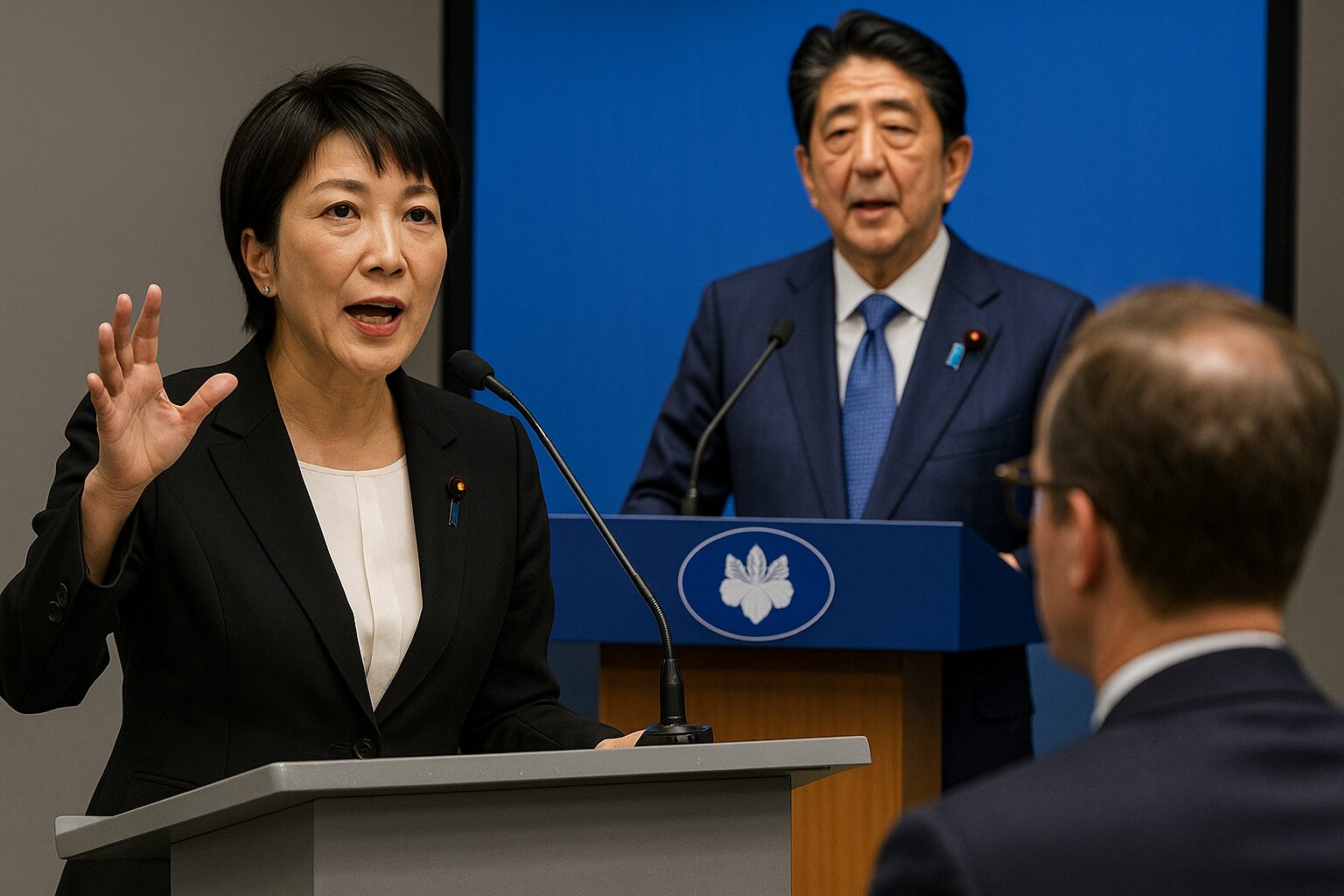Sanaenomics Begins: Japan’s First Female Prime Minister and a Market Near 50,000 — Euphoria or the Buying Climax?

October 15, 2025, is set to mark a historic day: Sanae Takaichi will become Japan’s first female Prime Minister after winning the Liberal Democratic Party’s leadership race on October 4.
Markets didn’t wait for the official inauguration. The Nikkei surged nearly 4.7% today, pushing toward the symbolic ¥50,000 line.
This is more than a political milestone — it’s the birth of a new economic narrative already dubbed “Sanaenomics.”
What Is “Sanaenomics”? The Continuation and the Shift
Like “Abenomics” — the well-known triad of monetary easing, fiscal stimulus, and structural reform — Sanaenomics also aims to spur growth through public investment and coordination with the Bank of Japan.
But its rhythm is different: faster, more government-led, and more pragmatic.
In her inaugural LDP address, Takaichi declared with unmistakable resolve:
“I will abandon the term ‘work-life balance.’ I will work, work, work, work, and work.”
This line — “to work” repeated five times — instantly became symbolic of her drive and uncompromising energy.
It signaled that Japan’s new leader intends to push through reform with relentless focus, blending urgency with conviction.
This determination also reflects an acute awareness of the Liberal Democratic Party’s current vulnerability as a minority ruling bloc, the public’s disillusionment stemming from scandals and fatigue after years of one-party dominance, and Japan’s declining international competitiveness.
Inherited from Abenomics
- Bold fiscal and growth investment — “Dynamic crisis management and growth spending” echo Abe’s “three arrows.”
- Government–BoJ coordination — She emphasizes that maintaining stability is the government’s responsibility, hinting at continued policy accommodation.
- Fast-acting, on-the-ground approach — From fuel-tax revisions to SME support, she favors immediate action over lengthy debate.
Where Sanaenomics Diverges
- Stronger fiscal bias — A full-throttle stance risks higher bond yields and future fiscal strain.
Indeed, the 10-year Japanese government bond yield climbed toward 1.7% today — its highest level since 2008, a 17-year high — underscoring the market’s concern over potential fiscal expansion under Sanaenomics.
- Gradual tax reform — Rather than immediate consumption-tax cuts, she favors targeted credits or deductions.
- Less structural reform — The pragmatic focus on short-term relief may dilute the deeper reforms Abe once sought.
Unlike Abe, whose international diplomacy and global messaging helped attract foreign capital, Takaichi’s Sanaenomics still needs to prove its ability to draw overseas investment into Japan’s markets.
Abe’s diplomatic strength also played a pivotal role in restoring Japan’s global standing — most notably with Tokyo’s successful bid for the 2020 Olympics, a symbolic victory that embodied his “Japan is back” narrative.
He even went so far as to tell investors in London, “Buy my Abenomics” — a confident appeal that symbolized his commitment to reviving Japan’s markets through global capital and reform.
I still remember how I was most bullish on Japan equities around 2012 — the dawn of Abenomics, when hope, policy, and markets moved in perfect sync.
And then came the “Kuroda Bazooka” — the Bank of Japan’s massive monetary easing in April 2013.
Markets exploded in response: the Nikkei soared, the yen plunged, and a sense of revival swept through Tokyo.
Back then, it almost felt like the BOJ itself was telling investors, “Don’t worry — we’ll support the market. You just buy first.”
It was the golden age of the so-called “government-backed rally.”
Market Reaction: A Celebration or a Buying Climax?
Today’s rally carried the hallmarks of a potential buying climax: a strong open, relentless dip-buying, and a euphoric close on heavy volume. Trading activity hit 30.3 billion shares on the Tokyo Prime Market, with a total value of ¥7.89 trillion — roughly triple the turnover seen in the mid-2000s, when I worked in the securities industry. It was truly a day of record enthusiasm and liquidity.
While headlines celebrated the dawn of a new era, experienced traders recognized familiar signs of excess.
- +4–5% index move — typical of post-event overshooting.
- Long-bodied bullish candle with minimal wicks and heavy volume — a textbook sign of euphoric buying.
- Expectation-driven catalyst — momentum, not earnings, leading the charge.
Valuation Check: Is ¥50,000 Justified?
Let’s quantify the excitement using 2026 EPS assumptions and implied PER levels.
| Assumed EPS (2026) | Implied PER at ¥50,000 |
| ¥2,400 | 20.8× |
| ¥2,500 | 20.0× |
| ¥2,600 | 19.2× |
A PER in the 19–21× range is high but not absurd — roughly on par with 2007 pre-Lehman levels, far below the 1989 bubble’s 60×.
Yet sustainability depends on three levers: earnings growth, interest-rate trends, and FX stability.
Historical Perspective of Japan’s Stock Market
- 1989 Bubble Peak (~¥38,900): PER ≈ 60× — irrational exuberance.
- 2000 IT Bubble (~¥20,800): PER 30–40×.
- 2007 Pre-Crisis (~¥18,300): PER 18–19×.
At today’s 19–21×, Japan sits at the upper edge of rational optimism — not yet a bubble, but fragile. History also reminds us that major reversals often occur around round-number milestones — points where euphoria and psychological resistance tend to collide.
Taken together, conditions are lining up for a possible correction: stretched valuations, soaring volumes, rising yields, and a psychological round-number barrier near 50,000. While not yet a confirmed top, the ingredients for a pullback are clearly in place.
With ¥7.9 trillion traded near the 50,000 level, one can’t help but wonder — who’s left to buy from here? The market feels fully loaded on optimism.
My Take: Stay Rational When the Market Seems Not
Today’s surge shows the characteristics of a short-term peak pattern.
As a day trader, I don’t rule out long positions, but this feels like a phase to avoid chasing momentum and let the market cool off a bit.
The key question from here is simple: Will earnings growth justify the price?
If we see a large bearish candle on heavy volume — a post-celebration hangover — that will mark the market’s digestion phase.
Any buy-the-dip opportunity will likely emerge only after several days or weeks of volume reset.
Her fierce pledge — “I will work, work, work, work, and work.” — undeniably fueled today’s surge.
But markets, as always, have their own rhythm: they buy on hope and sell on fact.
Whether “Sanaenomics” becomes a lasting growth story or just another celebratory spike will depend not on words, but on what comes next. Stay rational, stay patient.







